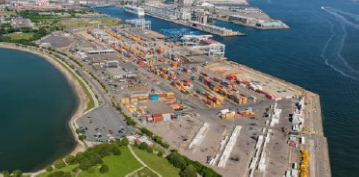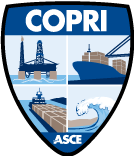
The Project Excellence Award was established by the COPRI Governing Board in 2008 to give members the opportunity to showcase their projects to the community. The purpose of this award is to recognize projects that have demonstrated design and/or construction excellence in the area of coastal, oceans, ports and harbors, or rivers. The projects selected for the award emphasize design excellence and innovation. The Project Excellence Award recognizes significant achievement through:
- Design or construction concepts
- Use of new or existing analytical techniques or technology
- Adaptive reuse of existing features or infrastructure
- Methods or innovations that minimize environmental impacts
The 2022 COPRI Project Excellence Award winner is the Conley Terminal Modernization Program – New Berth 10 Construction Project, nominated by the Massachusetts Port Authority. Congratulations to our awardee!
Conley Terminal Modernization Program – New Berth 10 Construction Project
The 101-acre Paul W. Conley Container Terminal (Conley Terminal) in Boston, MA, operated by the Massachusetts Port Authority (Massport) is New England’s only deep-water full-service container terminal. Conley Terminal plays a significant role in the regional economy by moving roughly one-third of the New England cargo in and out of the market. To maintain its competitiveness, in 2014, Massport commenced the Conley Terminal Modernization Program, an $800 MM investment into the infrastructure of the Port of Boston. The program included the expansion of Conley Terminal yard onto an adjacent property, the location of a former oil storage facility and construction of a new deep-water berth (New Berth 10 Construction).
The New Berth 10 Construction project involved the installation of a new 1,200 foot long bulkhead along the shoreline, dredging approximately 330,000 cubic yards of material and underwater rock blasting of approximately 10,000 cubic yards of rock to achieve a target dredge depth of -50 MLLW, and construction of a pile supported deck. The project also included procurement of three new low-profile ship-to-shore cranes and construction of a new substation and other new electrical infrastructure that can support the loads of the new cranes.
The project was completed ahead of schedule, finished under its budget, had very few safety incidents and no cases of COVID. The project was designed so that the maximum crane size and lift heights were achieved without impacting flight paths to Logan International Airport. The project eliminated persistent seeps and sheens into the Reserved Channel from a historically oil contaminated property. Urban fill, oily soil, and sediment was treated, rendered inert, or processed and retained on-site. The project eliminated 12,200 truck trips, which resulted in the elimination of the use of an estimated 48,650 gallons of truck fuel, which translated to an estimated elimination of 3.70 short tons of NOx emissions and an estimated elimination of 547.32 short tons of CO2 emissions for the project.
The new wharf and cranes were designed to be resilient. To ensure that future flooding at Conley Terminal will not impact the operation of the new Berth 10 several resiliency measures were implemented during the design process. Electrical power to the new ship-to-shore cranes was constructed above future flood elevations to ensure that switchgear and transformers would not be inundated and would be able to continue to provide power. Further, higher voltage electrical cables were used to carry electricity to the new cranes, and transformers (that otherwise would have been located within wharf switch-houses) were instead included in the electrical rooms of the cranes themselves.


